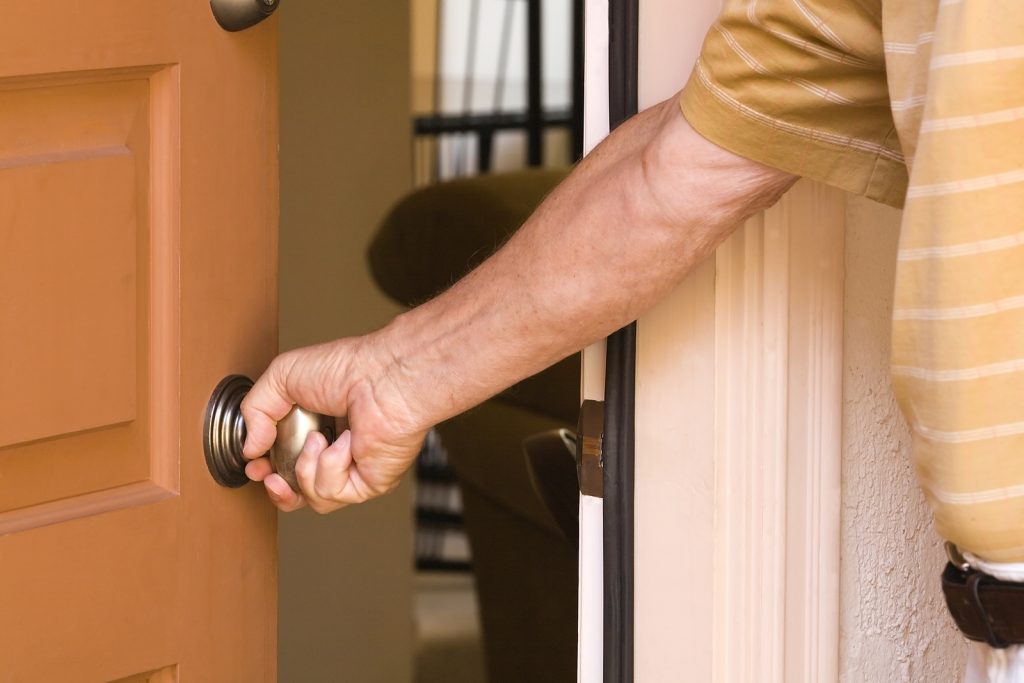
Rather than an easy to use, low-effort lever handle, this typical door knob takes more power to use
As is true with many things in life, the more financial means that someone has, the more choices and flexibility they have in making choices. Making home improvements and selecting finishes, appliances, components, and designs are no different. The larger the budget, the more that can be done.
However, this does not preclude smaller budgets or more modest home values from participating in aging in place improvements that will enhance their overall function, safety, convenience, livability, and comfort. It doesn’t take that much money to create effective modifications. Clearly, more money to invest can mean that more can be done, but something can always be done, even with seemingly no means.
We’d like to be able to offer at least something to everyone, and literally, we can. There are four improvements that we can make to any home that doesn’t already have them that will make them more functional and valuable. While there are higher quality products and finishes for the products that we’ll be discussing, many of them are only available in a same-look appearance so the price point is relatively immaterial. This means that everyone can enjoy these four essential features regardless of how much money they have (or don’t have) to devote to improvements.
Additionally, these four improvements have nothing to do with someone’s lifestyle, household size, or even the age of the home except that the newest homes may already have some of them – and possibly all of them.
In terms of safety and ease of completing, the first priority for every home should be to remove every non-LED bulb (incandescent, fluorescent, xenon, halogen, or other). In addition to most of these other bulbs being very hot to the touch because of the amount of heat energy they generate – and a potential source of starting fires if flammable materials come into contact with them or rest on them – they are not as healthy for us to use and have in our homes. They tend to produce glare, hot spots, and other issues that tire or irritate our eyes.
Homeowners themselves – with a little coaxing from us on size (lumens) and color (degrees Kelvin) – or with us being retained to do it for them if balancing themselves while working overhear standing on a ladder is going to be an issue for them, can replace each bulb for under $20 each and often considerably less than this. If they can’t afford to do it all at once, they can space it out, doing them over time as they have the money to fund it. Occasionally there are rebates or other incentives from manufacturers, power companies, public utilities, or local governments to accomplish this so check to see if this might be the case.
The second improvement, and next in priority, is to replace every non-rocker light switch in the home with this control. The older-style toggle control are more difficult to operate for people with lower vision or hand dexterity issues. Additionally, the rocker switches (also known as Decora because this is the manufacturer who popularized this trend) are more stylish and contemporary-looking that the older toggle-style switches. The older switches look dated by comparison and aren’t as functional or in keeping with universal design styling.
Likely, homeowners aren’t going to feel comfortable or competent in making these changes themselves since there is electricity involved; however, it is not a difficult procedure. Similar to the light bulb changes, making these improvements are not very expensive to accomplish either and can be do all at once or a little at a time. Also, like the light bulbs, these switches have a very long life span so they can be considered sustainable design.
The third feature to replace in our clients’ home is the entry door hardware – and interior doors after that. Unless the door handle is a lever style already, it should be replaced. This facilitates a wide range of abilities being able to use them without difficulty. They are universal design and highly desired. Start with the entry door and then move on to the interior doors. Some may have them already, but for those that don’t, these features should be added to our clients’ homes. Cabinet door and drawer hardware is a similar and related issue but can come later in the improvement process.
The fourth feature that we should target for replacement in those homes where this is not already included is the single lever faucet in the kitchen. It’s beneficial in the bath also, but the kitchen is the main focus initially. This means that anyone – of any size, vision, reach, strength, or other abilities – can operate this faucet easily. Moving it from the rear (12:00 position) more toward the front on either side when possible is a distinct benefit as well.
After completing these four essential fixes, there are other similar ones that we can apply, but this will get us started – and the public in general – with safer, more comfortable, convenient, and accommodating living spaces.
